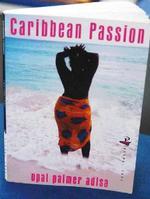
Title: Caribbean Passion
Author: Opal Palmer Adisa
Publisher: Peepal Tree
Press Ltd
Reviewer: Tanya Batson-Savage
OFTEN IT is best to ignore the blurb on the back of a book. They generally come from a prejudiced source, and sometimes only serve to taint what you will find wrapped between the covers. The blurb on Opal Palmer Adisa's collection of poetry Caribbean Passion is a rarity. It is a very apt description of the poetic gems that one can uncover in this text.
Unlike the explorers of yore, the Caribbean treasure is not
fiction, nor is it buried. As soon as one sifts through the first few pages, the bounty of good poetry is yours. Caribbean Passion provides a rich texture of Caribbean life, the good, the bad and never the indifferent. The poems weave together images of history, oppression, freedom, sex, sexuality, sexual oppression, young girls discovering desire and old women who refuse to let go of it. Life bubbles between these pages.
The poems are filled with metaphors that resound in the language, imagery and feel of the Caribbean. In several of the texts, her metaphors rely on fruit and flowers, or trees. This fruit basket of poetry often provides delightful double entendres that revel in the sweet stickiness of the fruits they use. She plays with the erotic though nourishing possibilities of food, with abilities that would make a calypsonian jealous.
Naseberry is a striking example of this. The poem begins with imagery that races between the body and fruit, "My tongue/ trace your inner thigh/ spilling naseberry everywhere". It then flows into erotic overdrive before ending with echoes of Shakespeare with the lines "oh to be smeared/ with such fruit".
REALITY
Some of her imagery is hot enough to tempt one to drop the book from the heat produced. Oleander may well induce this effect as it begins with the lines, "Earth lying wid/she legs spread/from di piece of loving/ rain drop down pon ar" is one of those. It is interesting, that even at her raunchiest Palmer Adisa's poetry is never raunchy simply because it can be. As such, like several of the poems in that segment, Oleander' ends with which echo and double in on themselves to find meaning.
With equal dexterity of imagery, Palmer Adisa uses food to map the darker side of romance and sexuality. With Stinking Toe she deals with being scalded by love, or rather an ill-advised tryst spurred by lust. The possibilities to be found in the food imagery go even further with Asham. Here the ground corn and sugar treat represents the compressed wisdom of older women which can help the younger woman to navigate a world filled possessing male predators, as its taste can be used to take the "shame from the taste in my mouth".
As much as it glories in taste, Palmer Adisa's poetry also uses the symbolic value of colour. In poems such as Lime, Star-apple, Poui and Poinsettia she plays on both the nature and colour of the fruits and flowers of which she speaks.
PASSIONATE
Caribbean Passion opens and ends with poems which evoke a very different kind of passion. The first work in the text takes the Caribbean back to its beginning, pre Columbus with An Arawak Speaks. Despite the continued misnaming, the poem helps to give voice to the now decimated Tainos. Tide Turn continues the trend, though it could easily refer to both the Taino and African experience in the Caribbean, as both cultures wet Europe on a site of 'debauchery'. Indeed, though some of the imagery in this poem is sexual, it is not erotic, instead leaving a sour taste in the mind as it evokes the horror of the meeting of cultures.
Interestingly, after dealing with love, lust, mother daughter relationships and how being from the Caribbean shapes a
specific identity even when one has migrated, the poems come back to a contention created by the meeting of Africa and Europe. This time it is focused through the lens of Haiti, with the poems Boat People and Those Who Didn't Make It.
CARIBBEAN IDENTITY
The collection ends with Fi Me People which celebrates a Caribbean identity. However, the true celebration had come in all the poems before. It had been created with her descriptions which constantly displayed the Caribbean in metaphors like 'mawga ribs of a hillside' and in the way that the poems meander between Standard English and creole, sometimes not quite settling on either. The Caribbean identity is expressed in the way that some of the poems spread themselves across the page, seemingly in defiance of too much order.
At the heart of it all is a love for and understanding of the power of words. This comes through clearly with the Head In Idea which is dedicated to Kamau Brathwaite. In celebrating Brathwaite, the poem
celebrates the importance of the word to shape our identity. Indeed, by using Caribbean food, fauna and landscape to shape her meanings, Palmer Adisa adds validity to the Caribbean way of seeing, thinking, living.

